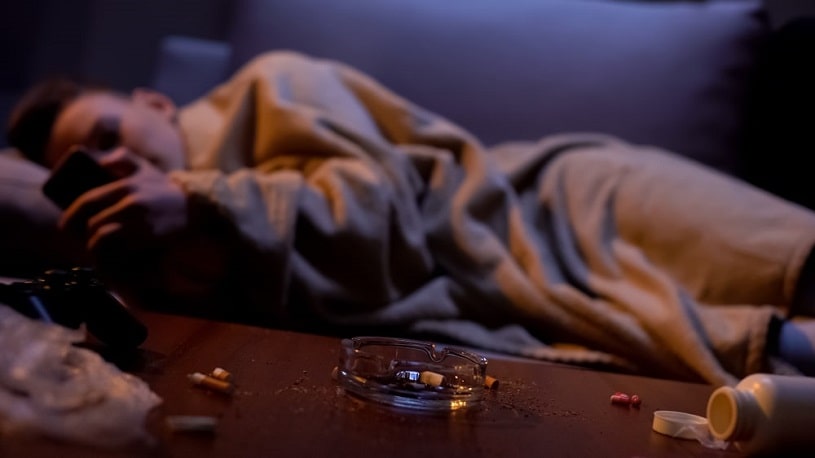Nicotine withdrawal is a usual physical and emotional reaction to rapidly quitting or significantly reducing the substance intake. Once the body adapts to regular tobacco use, people find giving up smoking difficult due to the unwanted outcomes. This article will discuss nicotine withdrawal, its symptoms, timeline, and tips on coping with it.
Table Of Contents:
Nicotine Withdrawal Overview
A highly addictive yet legal drug, nicotine is a stimulant found in many forms, commonly cigarettes and e-cigarettes or vapes. It increases heart rate, circulation, and dopamine production that translates into feelings of pleasure and relaxation that wear off quickly because it does not stay in the body long.

According to a 2015 survey, about 70 percent of current adult smokers in the United States wanted to quit, and only 7 percent were successful in quitting for 6-12 months. Removing the stimulant causes people to experience physical signs within hours of quitting, usually peak after 1–3 days and decrease for 3–4 weeks. After this time, the body has expelled most of the drug, and the effects are mainly psychological.
Causes Of Withdrawal from Smoking
The U.S. Department of Health and Human Services reports that approximately 80 to 90 percent of usual smokers are nicotine addicted. Every day, numerous Americans consume tobacco products like cigarettes. It occurs because of dependence when the body becomes used to having the drug in the body. Once nicotine leaves the system, the unpleasant symptoms occur, as the person’s body needs to adjust to the absence of the drug.
Being an extremely addictive drug existing in tobacco products, it is the core cause of people remaining to consume tobacco even while they think of quitting. A recent NIDA-sponsored study showed that two separate brain processes are linked to withdrawal, which may account for some of the difficulties in stopping smoking.

Individuals often experience nicotine cravings when they are reminded of their past tobacco use. Staying with a friend who is an active smoker or visiting a restaurant where smoking is not prohibited may trigger cravings. When the potential quitters suddenly stop using tobacco, a range of distressing signs occurs. These nicotine effects do not last forever, but people suffering from the after-effects often start smoking again to make them disappear.
Nicotine Withdrawal Symptoms
According to the Diagnostic and Statistical Manual of Mental Disorders Fifth Edition, symptoms occur in 50% of the users who quit for two days or more. The symptoms of nicotine withdrawal are usually not life-threatening. However, below mentioned symptoms could be risky and maybe an outcome of a significant level of discomfort, often resulting in a relapse.
Those who use it for a long time are more likely to experience such symptoms. They can initiate as fast as 2-3 hours after quitting. The following signs must be present upon cessation of smoking for it to be considered withdrawal:
Psychological Symptoms Include:
- A strong desire (nicotine cravings)
- Irritability or frustration
- Depressed mood
- Difficulty concentrating
- Anxiety
- Mood swings
- Impatience
Physical Symptoms Include:
- Headaches
- Sweating
- Sore throat
- Restlessness
- Tremors
- Weight gain
- Difficulty sleeping
- Slowed heart rate
- Insomnia
- Increased appetite
Everyone experiences it differently, but any combination of symptoms can cause significant distress. Smokers with mental health or substance use disorders are likely to experience more severe symptoms. Using it again gets rid of the symptoms; consequently, 85% of people who try to quit relapse within a week.
Nicotine Withdrawal Timeline
Physical symptoms peak within days of quitting. They tend to go away after a few weeks and rarely last past one month. The behavioral connections, rituals, and habits created with its use tend to make quitting much harder. Nicotine withdrawal timeline includes cravings that may last for a longer duration and gradually decrease over weeks or months.

Within the first 24 hours, the symptoms start to emerge. A person might feel psychological and physical discomfort and a desire to smoke again. During the next days (day 2-3), the symptoms peak and may include any previously described events. After 2 or 3 weeks, most of the outcomes mentioned gradually disappear. The total duration of symptoms may depend on the frequency, dose, and duration of its use. The cravings may persist for a more extended period, especially when facing triggers that remind of smoking.
According to the U.S. Department of Health and Human Services, usually within a week, as the intensity of nicotine withdrawal symptoms elevates, the users start consuming it once again. Within two hours of the last cigarette, the system has already flushed almost half of the nicotine. The levels of the substance continue to decrease till the next few weeks, depending on factors like history of use, till it no longer disturbs the system.
The nicotine withdrawal timeline is short but challenging for most smokers. However, the good news is that the worst symptoms usually last less than two weeks, but that time can be challenging.
Treatment For The Withdrawal
A physician can advise going for nicotine replacement therapy, which helps the users get rid of tobacco products. Replacement products provide calculated doses of the addictive substance into the system that help relieve the cravings and signs that people are trying to quit smoking.

The U.S. Food and Drug Administration (FDA) has approved five forms of replacement therapy products available both by prescription and over-the-counter for adults aged 18 and over. Replacement therapy products are widely used at the start of the treatment and then tapered off with time. Research has revealed that NRTs give rise to the rate of quitting by 50 to 70%. At that time, the user can eventually decrease its dosage until no further treatment is necessary.
Behavioral treatments like cognitive-behavioral therapy (CBT) can likewise be beneficial. CBT works to alter the thought patterns and behaviors within a person responsible for making someone lead to smoking. Other medications like bupropion or varenicline are also effective in reducing nicotine cravings and alleviating the signs of withdrawal.
Coping With The Symptoms
In case the individual is going through some adverse nicotine withdrawal symptoms, it’s helpful to discover approaches to divert them from the withdrawal impacts. The individual may remain active by participating in sports activities or activities that are of the individual’s interest, like painting, dancing, etc. Learning any new skill of interest also diverts one mind from craving. Also, being with family and friends would help overcome the side effects of withdrawal. Proper sleep and rest is additionally a powerful way to overcome troubling results.

Gradually reducing the dose of nicotine consumed over time can help decrease drug dependence while avoiding its signs. People should remember that many cravings would only last for 15–20 minutes. This denotes that they may keep themselves busy with some task at the time of craving until it passes.
Here Are a Few Tips Which Can Help in Coping With Nicotine Withdrawal Symptoms:
- Firstly, one should prepare their mind and body for quitting nicotine and its withdrawal symptoms.
- Take warm drinks in case of increased coughing.
- Starting a healthy lifestyle also helps in easing the withdrawal symptoms. To overcome hunger and constipation, eat fruits and vegetables or drink lots of water.
- Chewing sugar-free gum can also help overcome cravings.
- Regular exercise and taking slow deep breaths can help reduce stress.
- Avoid triggers like drinking alcohol or going to particular places.
- Include social stress by announcing to family and friends the decision to quit. Also, ask them to support and respect the decision.
- Spend time with family and friends who do not smoke.
- Develop a new meaningful habit to stay busy and protected from cravings.
Symptoms of nicotine withdrawal are not life-threatening, but they can still be uncomfortable and may feel overwhelming at times, particularly in the first week. Before the user begins abstaining from tobacco, it is important to consult the doctor. He or she can provide some tips for quitting smoking or prescribe medications approved by the Food and Drug Administration for treating nicotine addiction.
The user should be careful only to use nicotine replacement therapies as recommended. Overusing these products can lead to nicotine overdose.
However, there is no health danger from the withdrawal. Even extreme signs will fade over time.
Some individuals feel a rush of sadness after they quit smoking. Look out for this, especially if the user has ever had depression. Let a friend or family member know, and think about talking to the doctor. Professional rehab centers can be approached to receive the proper support and treatment required to overcome withdrawal symptoms of nicotine.
Hope Without Commitment
Find the best treatment options. Call our free and confidential helpline
Most private insurances accepted
Page Sources
- National Institute on Drug Abuse, Mind Matters: The Body's Response to Nicotine, Tobacco and Vaping, 2020. https://teens.drugabuse.gov/teachers/mind-over-matter/nicotine/how-does-nicotine-act-brain
- FDA, Quitting Smoking: Closer with Every Attempt, 2021. https://www.fda.gov/tobacco-products/health-information/quitting-smoking-closer-every-attempt
- Smokefree, Understanding Withdrawal, https://smokefree.gov/challenges-when-quitting/withdrawal/understanding-withdrawal
- Centers for Disease Control and Prevention (US); National Center for Chronic Disease Prevention and Health Promotion (US); Office on Smoking and Health (US). How Tobacco Smoke Causes Disease: The Biology and Behavioral Basis for Smoking-Attributable Disease: A Report of the Surgeon General. Atlanta (GA): Centers for Disease Control and Prevention (US); 2010. 4. Nicotine Addiction: Past and Present, https://www.ncbi.nlm.nih.gov/books/NBK53018/
- The Nature Of Nicotine Addiction." Institute of Medicine. 1994. Growing Up Tobacco Free: Preventing Nicotine Addiction in Children and Youths. Washington, DC: The National Academies Press. , https://www.nap.edu/read/4757/chapter/5#41
- McLaughlin I, Dani JA, De Biasi M. Nicotine withdrawal, 2015. https://pubmed.ncbi.nlm.nih.gov/25638335/
- National Cancer Institute, How To Handle Withdrawal Symptoms and Triggers When You Decide To Quit Smoking, Reviewed: October 29, 2010, https://www.cancer.gov/about-cancer/causes-prevention/risk/tobacco/withdrawal-fact-sheet
- Baker TB, Breslau N, Covey L, Shiffman S. DSM criteria for tobacco use disorder and tobacco withdrawal: a critique and proposed revisions for DSM-5, 2012. https://www.ncbi.nlm.nih.gov/pmc/articles/PMC3246568/
- Corelli RL, Hudmon KS. Medications for smoking cessation. West J Med. 2002. https://www.ncbi.nlm.nih.gov/pmc/articles/PMC1071687/
- McLaughlin, I., Dani, J. A., & De Biasi, M. Nicotine withdrawal. Current topics in behavioral neurosciences, 24, 2015. https://www.ncbi.nlm.nih.gov/pmc/articles/PMC4542051/
- Benowitz NL. Pharmacology of nicotine: addiction, smoking-induced disease, and therapeutics. Annu Rev Pharmacol Toxicol. 2009. https://www.ncbi.nlm.nih.gov/pmc/articles/PMC2946180/
- Smokefree.gov, Nicotine Withdrawal, https://smokefree.gov/challenges-when-quitting/withdrawal
- NIDA, What are treatments for tobacco dependence? 2020. https://www.drugabuse.gov/publications/research-reports/tobacco-nicotine-e-cigarettes/what-are-treatments-tobacco-dependence
- Wadgave, U., & Nagesh, L. Nicotine Replacement Therapy: An Overview. International journal of health sciences, 2016. https://www.ncbi.nlm.nih.gov/pmc/articles/PMC5003586/
- Jiloha R. C. Pharmacotherapy of smoking cessation. Indian journal of psychiatry, 2014. https://www.ncbi.nlm.nih.gov/pmc/articles/PMC3927255/
- Better Health Channel, What to expect when you quit smoking, 1999/2021, https://www.betterhealth.vic.gov.au/health/healthyliving/What-to-expect-when-you-quit-smoking

 Authored by
Authored by  Reviewed by
Reviewed by 